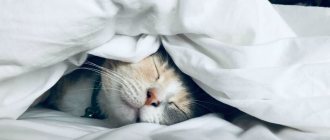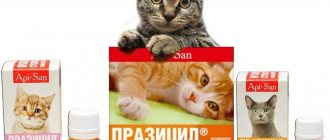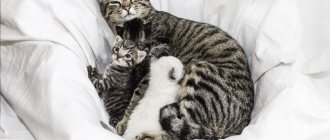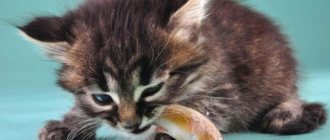Signs that your cat is about to give birth
A loving and caring owner should pay attention to many characteristic signs by which one can recognize that a cat is preparing to give birth.
Pregnancy in pets lasts 65–70 days. The first symptoms appear a week before birth. By these signs, a person will learn how to understand how soon a cat will give birth. The owner has several days to prepare her for the birth, and the apartment for the arrival of newborn kittens.
You should prepare in advance for the arrival of newborn kittens.
Signs that occur a week before giving birth
About 7 days before labor begins, the cat drinks a lot of water, becomes lethargic and apathetic, eats very often, but little by little. Many noticeable changes occur in the body as it prepares for childbirth. The animal's nipples swell and she runs to the toilet more often.
Important! You can ask your veterinarian about how to know if your cat is giving birth. It is advisable to show your pregnant cat to a doctor and give her an ultrasound.
The pet meows loudly, often approaches its owner and asks to scratch her tummy. When petted and scratched, she purrs loudly. At this time, owners need to be very attentive and sensitive towards the cat. It is advisable not to leave her alone, to caress and calm her down.
A pregnant cat has become very restless in recent days
Behavior 2–3 days before birth
2-3 days before the onset of labor, the animal becomes very restless: it looks for a secluded place, it can climb into closets, boxes, and hide in corners. If a cat has its own house, it hides in it. She constantly walks in circles inside the bed, trampling all the lumps and lumps into the fabric. It is advisable to arrange a cozy, warm house for her in a quiet place. You can place soft towels or knitted rags in a carrier or cardboard box.
Note! So that no one disturbs the kittens, you need to fence off this place with a screen or set aside a separate room for them.
Pregnancy lasts up to 70 days
Signs of labor that will take place in 1–2 days
A day before giving birth, the cat's stomach drops. The same thing happens in pregnant women. The body temperature drops to 37 °C, the animal refuses to eat, and constantly licks the entire body, especially the genitals. The expectant mother's mammary glands swell and milk may leak from the nipples.
If your stomach begins to drop, you should wait any day for replenishment
Signs that she will give birth today
When the owner understands that the kittens are due today, he should begin preparing for their arrival as quickly as possible. The most characteristic symptom is that the cat's belly becomes very hard and tense. The muscles of the pet's abdominal cavity become very tense, and after a while contractions begin. The cat refuses food and drinks only water or milk. The external genitalia swell.
When the stomach becomes hard, the animal will give birth on that day
How to prepare a nest for a cat?
A nest is a place where a cat gives birth and raises kittens. Kittens stay there for up to 1-1.5 months. It is best to use a cardboard box without foreign odors as a nest. Boxes of strong-smelling household, paint, and perfume products will cause rejection in the animal.
Boxes of aromatic food products - sausages, cheeses, fish - are also not suitable. Cardboard should not smell like anything.
At the bottom of the box you need to put several waterproof diapers - veterinary, children's or surgical. During the birth process, one or two of them will be wet and soiled with amniotic fluid, mucus, and blood.
Dirty and wet diapers will need to be removed and left clean and dry. It is advisable to keep the diapers that were already at the bottom of the box at the time of birth, since they will retain the smell of the cat, and she will not be nervous about changing the bedding.
Cat houses are not suitable as a nest. It will be difficult to wash them off from mucus and blood. In addition, in the house it is difficult to observe the giving birth and provide assistance to her.
If there is no nest, the cat can settle in the closet on clothes, on the sofa on bed linen or on the kitchen table. Then she will bring the born offspring there, risking the destruction of the litter.
Harbingers of childbirth among sphinxes
How to understand that a cat is pregnant: signs
Sphynx pregnancy lasts approximately 63 days. A cat gives birth to 3–6 babies. The first signs that she is about to give birth are the release of milk from the nipples, loss of appetite and restlessness. The onset of labor manifests itself with contractions and pushing. Soon they become stronger and more intense. After some time, the mucous plug that covered the uterus will come out of the vagina.
The next stage is the most difficult and responsible. The first kitten begins to emerge. He can be born with or without a shell (bladder, or jacket). The cat easily breaks the shell and licks the baby. First of all, the mother licks the kitten's face, clearing its airways. Now the baby can breathe on his own.
Childbirth for an animal is a complex process, in which the owner’s help is sometimes needed
The birth of the first child lasts for 5–60 minutes. If the process takes more than an hour, then you need to sound the alarm and call the veterinarian, as this indicates complications.
Next, the third stage of labor begins - the placenta, with the help of which the kitten received nutrition in the womb, comes out. The cat chews the umbilical cord and often eats the placenta. Then she pushes the baby towards the nipples, and he reflexively begins to suck the milk. If she has not chewed the umbilical cord, you can cut it yourself with a thread.
Then the remaining kittens are born. Each of them has a separate placenta, so the owner must carefully ensure that the number is the same as the kittens.
Important! It is very dangerous when the placenta remains inside the cat. This can cause inflammation and even lead to the death of the animal.
The birth of each kitten occurs in the same way as the birth of the first. Contractions intensify, and within 10-60 minutes. The next baby in line is born. This happens until all the little sphinxes are born.
Sphynxes give birth just like all other representatives of other breeds
Duration of labor - what does it depend on?
The duration of labor is determined by several factors:
- age;
- physiological characteristics;
- number of births;
- breed;
- living and feeding conditions;
- hormonal balance;
- individual characteristics.
Most often, several hours pass from the moment the first kitten is born to complete delivery, however, there have also been cases when the birth lasted for several days.
In this case, you cannot disturb the cat; let it lie in its place, gradually giving birth to cubs. It is recommended to call a veterinarian at home in order to avoid possible complications.
Attention! An interesting fact is that in old age cats give birth to no more than 2-3 cubs, and childbirth is difficult. At the age of 9 years, cats do not bear offspring at all.
When birth approaches, the cat loses its appetite, it becomes lethargic and motionless, and actively seeks a secluded place. Preparing the nest in advance is not an option, as pets often do not approve of this area.
How to help a cat during childbirth:
- Lubricate your fingers with Vaseline or greasy cream.
- Insert them into the vagina and begin to slowly pull out the kittens.
- Support the pet's belly with your hand.
- Use light strokes to massage the back and abdomen to stimulate the appearance of new contractions.
- Do not pull the kitten by the head, which can lead to the death of the cub.
It is important to provide timely assistance to your pet, since unfinished childbirth is dangerous for the reproductive system and life of the cat. Take care of your animals and enjoy your time together.
Domestic cats usually give birth easily, with almost no pain, and the expectant mother successfully copes with this process on her own. But there are cases when labor stops while there is still a kitten in the womb. This is very dangerous - due to possible complications, your pet risks losing its health and even dying. Therefore, when a cat gives birth to offspring, its owner must be vigilant and be able to determine whether all kittens have been born, and whether the mother or her children require the help of a veterinarian.
Signs of childbirth in British and Scottish breeds
How to understand that a cat loves you - signs of your pet's feelings
It is impossible to predict when a British cat will give birth. On average, her pregnancy lasts 56-65 days. This depends on the cat's weight and age, and whether she is giving birth for the first time or repeatedly. A Scottish cat will be pregnant for 63–65 days. The expectant mother needs to be fed twice a day; it is advisable to increase her portion slightly.
Note! Under no circumstances should “British” and “Scottish” women be overfed, as they tend to become overweight, which can cause difficulty in childbirth.
A day before the onset of labor, British and Scottish cats begin to produce milk. The animal is alarmed, breathes heavily, and licks itself frequently. Within 2–3 hours the water breaks, and contractions soon begin. You should immediately contact a veterinarian if your cat has a high fever (or, conversely, drops too low) or green or black vaginal discharge with an unpleasant odor or bleeding. A caring owner carefully monitors the gestational age, as premature or delayed birth may occur.
The birth process itself proceeds the same way as in all other cats. But a loving owner must always be on the alert and monitor the well-being of their furry pet.
Scottish cat with kittens
Unpleasant consequences after childbirth
Unfortunately, childbirth does not always go smoothly; various unpleasant consequences can occur. So, the first thing you need to pay attention to after childbirth is discharge. Any colored, unpleasant-smelling discharge is a deviation from the norm. If a cat has intense pink discharge, this is a sign of a fungal disease of the genital organs.
Watery discharge is possible, which may be caused by blood accumulation in the uterus, uterine rupture, or rupture of sutures (during caesarean section).
If after birth the bleeding does not stop for 15 minutes, you should urgently take your pet to the veterinarian and provide qualified assistance.
Another problem after childbirth may be the lack of milk. The reason may be the stress of the mother in labor, so you should create comfort and ensure peace of mind for the mother, feed her well and let her drink milk.
It often happens that after giving birth a cat is left with a hanging belly. The reason may be that there is a dead kitten in the stomach. You need to carefully feel the cat's belly and take the animal to the veterinarian.
After giving birth, it is best to feed a cat with easily digestible food, milk with the addition of fish oil and calcium. Water supplies must be constantly replenished.
Preparing for childbirth: behavioral changes
How a cat behaves before giving birth: yelling and other changes in behavior
Before the kittens are born, the cat's behavior changes significantly. She carefully explores corners and secluded places. Having chosen the most suitable place, he brings rags there.
Expectant mother:
- chooses and arranges a cozy place;
- drinks a lot of water, but refuses solid food;
- meows loudly;
- worried and nervous.
Changes in your furry pet's behavior indicate that the cat is giving birth, so she needs help getting ready.
British cat with kittens
Symptoms of unfinished labor
To ensure a smooth birth, pay attention to the list of things you should not do:
- irritate the woman in labor with loud screams, numerous guests, parties;
- actively feel the stomach, as you may accidentally injure the cat or kittens;
- Give your cat medications on your own without consulting a specialist;
- ignore vomiting, discharge and changes in the behavior of the pregnant woman;
- allow your cat to come into contact with animals whose health status you do not know;
- allowing you to sleep in a dirty place, handling the animal with dirty hands, frequently changing the linen in the cat’s sleeping area;
- use chemicals to clean the house.
The interval between newborns ranges from 15 to 120 minutes, but there are exceptions; sometimes the duration of labor lasts up to 36 hours, and then the process resumes.
Signs of labor:
- active pet care;
- The cat’s breathing is even, the heartbeat is rhythmic, there is no reason for concern;
- the cat shows appetite and can get up from the nest, leaving the brood for a few minutes;
- The mother's belly is soft on palpation, there are no compactions;
- after 40 minutes you need to check the cat’s stomach, but do not press, but place your palms on the sides and run along the hips;
- calm behavior of the woman in labor.
The uterus retains its tone after a day, and therefore this seal should not be confused with a kitten. If you have any suspicions, you can inject the cat with 0.3 ml of oxytocin, which stimulates the uterus and helps unborn kittens emerge.
Even if the delivery process is completed successfully, in any case such an injection will be beneficial - it will remove the remaining mucus from the uterus. It is not recommended to use drugs without a veterinarian, so as not to harm the pet.
We suggest you read: Breeding quails on the balcony
Attention! You should be concerned when your cat's temperature exceeds 39 degrees and dark mucus with an unpleasant odor comes out of the genitals. In this case, you cannot do without a specialist.
Problems with delivery may arise if the cat has already given birth to 5-6 kittens, and new contractions are slow and can drag on for a day. It is important to closely monitor your cat to prevent serious complications.
Within normal limits, the end of labor in a cat is characterized by the following signs:
- After about an hour had passed since the last kitten was born, the belly became soft.
- The cat may become separated from the kittens.
- When all the babies have been born, the cat may show interest in food or water.
- Breathing becomes smooth and heartbeat becomes calm.
- The new mother begins to take care of the born offspring, actively caring for the babies.
You need to feel the cat’s abdominal area quite carefully, without making any effort, using both hands, moving in the direction of the ribs. This should be done at least half an hour after the birth of the last kitten.
The calmness of a cat does not always indicate that the birth process has already ended. Most animals do not change their behavior during childbirth and after it ends. If you have doubts about whether there are any unborn babies left, you need to seek advice from a specialist.
Determining for the owner that there are still kittens in the cat’s belly can be extremely important for preventing the development of postpartum complications. A baby that remains in the womb can cause the death of a cat. If it is not alive, then after a few days decomposition will begin, and the cat will suffer from severe intoxication.
If there is a suspicion that not all babies were born, you need to carefully monitor the animal. There are a number of characteristic signs that indicate incomplete completion of delivery:
- The cat continues to behave as it did during childbirth.
- The new mother does not take the necessary care of the kittens, does not feed them, and does not lick them.
- She is in no hurry to replenish her strength with water or food.
- During palpation of the abdomen, seals are felt inside it, it is hard or tense. There is no feeling that there is nothing there.
- After 24 hours after birth, the cat’s temperature does not drop below 39 degrees.
- After 48 hours after delivery, blood is discharged from the birth canal, most often with an unpleasant odor.
All of the above signs suggest that not all kittens were born. In such a situation, an important decision would be to immediately seek qualified help. In a clinical setting, a face-to-face examination of the animal and palpation of the abdomen are performed, followed by an ultrasound examination, which will confirm or refute the assumption.
how to deliver a cat at home
Even if the delivery process is completed successfully, in any case such an injection will be beneficial - it will remove the remaining mucus from the uterus. It is not recommended to use drugs without a veterinarian, so as not to harm the pet.
Childbirth in a cat takes place in 3 stages. This process is complex and quite lengthy, which is why the owner should not plan any additional activities on the day of lambing. Also, the owner must know all the stages of childbirth and imagine how they proceed. The lambing process is divided into the following periods:
- breaking of water;
- release of kittens;
- separation of membranes.
Within 1-2 days after the birth of the offspring, the pet will shed suckers, which is the norm. During this period, you should not let the cat go for a walk. You cannot try to remove suckers from an animal by force, since the entire process must necessarily take place naturally, unless there are complications requiring medical intervention.
Determining that a cat is giving birth is not difficult. The appearance of the first real contractions, not training ones, leads to the fact that the cat lies on its side and begins to gradually arch its back, at the same time straining its stomach, which can be felt well if you place your palm on it. As the contractions intensify, the cat will begin to arch more and cry out frequently.
Premature birth
Sometimes labor can begin prematurely. Premature birth is always an incredibly complex and unpredictable process, fraught with complications. The most tragic and widespread of them is the death of newborn kittens. It is very important to monitor the mother’s well-being, otherwise you may also lose the cat.
The length of pregnancy varies slightly depending on the breed. Premature births are considered those that occur on the 60th day of pregnancy. Kittens born before this period most often do not survive.
Veterinary clinics perform resuscitation of premature kittens. If the cat refuses to feed them, you can feed them with an artificial formula, which is sold at any pet store.
For your information! Unfortunately, even if a premature kitten survives, it may have health problems and require special care.
If the owner realizes that the cat is going to lamb prematurely, he should immediately call the veterinarian or take the animal to the veterinary clinic. In addition to contractions, pathological childbirth can be recognized by mucus flowing from the pet’s vagina.
Causes of premature birth in cats:
- intrauterine infection;
- placental abruption (all kittens die);
- abdominal trauma, severe stress;
- miscarriage (all kittens are not viable);
- the death of one kitten (in this case, all other cubs have a chance to survive).
Any of these reasons requires immediate hospitalization of the cat. Surgery is almost always necessary.
Newborn kittens may be born prematurely
Have all the kittens been born?
Of course, such questions do not arise with the birth of one kitten. There are, of course, cases of the birth of a single baby, but they are rare. But let's assume that your pet has already given birth to three or four kittens. How can you tell if someone else is still in the uterus?
Only an ultrasound scan can give an exact answer to this question, but there are still signs that, when they appear, it is recommended to either immediately call a veterinarian or take your pet to the clinic yourself:
But you need to remember that oxytocin is not the safest drug, and therefore when using it you need to take into account important nuances:
- If after administration of the first dose (no more than 5 IU) no signs of contractions are observed, further administration should be considered pointless and even dangerous.
- If the cat's body temperature does not exceed 37.5° Celsius, it is also not worth artificially inducing labor.
- Bradycardia, tachycardia, and other cardiac or respiratory disorders are also contraindications for oxytocin.
Alas, there are no special guarantees. It is very possible that the kitten(s) are already dead due to hypoxia. So you shouldn’t particularly count on a successful outcome. But still, a caesarean section is an extremely important method, as it allows you to save the life of the cat itself.
True, in some cases it is still impossible to immediately operate on a pet. This is due to the fact that before surgery it is necessary to completely stabilize the animal’s condition, eliminating all signs of respiratory and heart failure. Otherwise, the cat may well die during the operation.
We hope that the article was useful to you. I would also like to remind you that in situations where the cat, as it seems to you, has finished giving birth, but she still struggles, it is better to immediately call a veterinarian. If you do this in time, there is a good chance of saving the life of the kitten and its mother.
Features of childbirth for the first time
If a cat gives birth for the first time, then this process has certain features. As in humans, the first birth in animals lasts longer than subsequent ones. For the first time, an animal can give birth within 2–15 hours. This time includes the process of discharge of amniotic fluid and prolonged contractions. After the birth of the third kitten, there is sometimes a 2-hour break in labor. The birth process ends when the last kitten is born.
It is advisable to read specialized literature to understand the peculiarities of childbirth in a cat and determine in what cases she will need help.
It is necessary to remember in what cases a cat needs medical attention:
- if the first stage (contractions and pushing) lasts more than 24 hours;
- if strong contractions last longer than 30 minutes, but the kitten never appears;
- if there is bloody or mucous discharge from the vagina;
- if the pregnancy period exceeds 70 days.
Attention and care will keep your furry pet alive and healthy.
During the first birth, the expectant mother especially needs the support of her owner.
How can a person help?
It is worth noting that all purebred cats have a reduced instinct, so they will need your help. The main ways a person can help:
- Prepare the area for lambing. A medium-sized, open-top box is best.
- Line the box with disposable diapers and change them when dirty.
- Have scissors ready in case the mother in labor does not gnaw the baby's umbilical cord herself.
- Purchase in advance a medicine that helps labor - calcium gluconate.
- You should always have a veterinarian’s phone number at hand so that you can get qualified advice and help from him if necessary.
- During lambing, make sure that the pet does not crouch. Lay her on her side, stroking her stomach and back.
- Provide the nursing animal with a complete, balanced diet.
Having safely experienced an important moment in your cat’s life, try for the first time, if the pet copes well with its maternal responsibilities, not to touch or pick up the babies.











